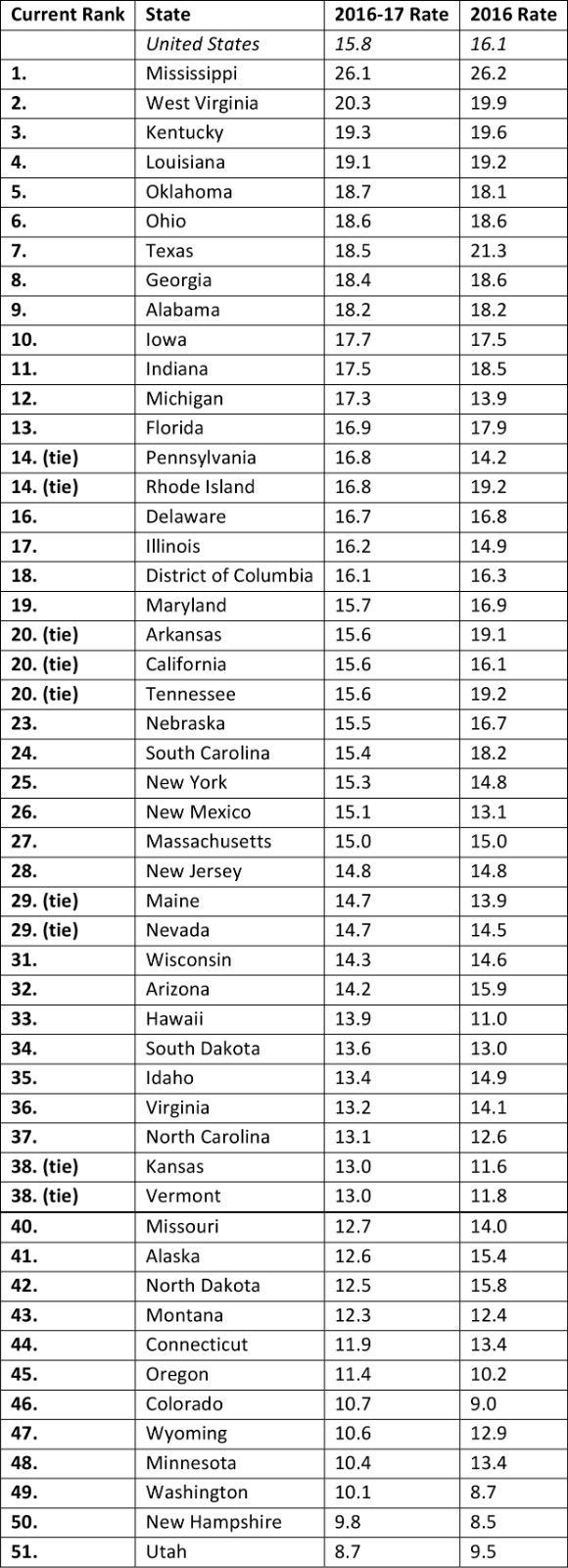October 24, 2018
Princeton, N.J.—Nationwide, 15.8 percent of young people ages 10 to 17 have obesity, according to the newest national data released today. Mississippi has the highest youth obesity rate, at 26.1 percent, while Utah has the lowest, at 8.7 percent.
The data and analysis were released today by the Robert Wood Johnson Foundation. They come from the 2016 and 2017 National Survey on Children’s Health (NSCH), along with analysis conducted by the Health Resources and Services Administration’s Maternal and Child Health Bureau. A full national data interactive, with information for every state, is available at https://stateofobesity.org/children1017/.
The new data show that racial and ethnic disparities persist. For instance, black youth had nearly double the rate (22.5%) as white youth did (12.5%). The rate for Hispanic youth falls between those two, at 20.6 percent, and Asian youth have the lowest rate, at just 6.4 percent.
“Childhood obesity continues to be a major public health challenge, with significant financial and societal implications,” said Jamie Bussel, senior program officer at the Robert Wood Johnson Foundation (RWJF). “Far too many young people in this country are facing increased chances of diabetes, heart disease, and high blood pressure, all due to a preventable condition. And black and Latino youth are still more likely than their white peers to face these problems. We must help all children grow up at a healthy weight, so they can lead healthy lives, and save the nation billions in health care costs.”
The new analysis uses combined data from the 2016 and 2017 editions of the NSCH. Comparing the combined 2016–17 data to 2016 alone, only one state, North Dakota, had a statistically significant change in its obesity rate, which dropped from 15.8 percent to 12.5 percent.
Scientists predict that more than half of today’s children will be obese by age 35 if current trends continue. To help prevent that scenario, RWJF urges policymakers at all levels to prioritize obesity prevention and help all children have a healthier future. Specific recommendations include:
- Congress and the Administration should maintain and strengthen essential nutrition supports for low-income children, families, and individuals through programs—like the Supplemental Nutrition Assistance Program (SNAP), the Child and Adult Care Food Program (CACFP), and the Special Supplemental Nutrition Program for Women, Infants, and Children (WIC)—and expand programs and pilots to make healthy foods more available and affordable through the program.
- The U.S. Department of Agriculture should maintain nutrition standards for school meals that were in effect prior to USDA’s interim final rule from November 2017, as well as current nutrition standards for school snacks.
- The U.S. Department of Education should maintain the Office of Safe and Healthy Schools, as well as Title I and Title IV programs under the Every Students’ Succeeds Act (ESSA), through which schools can receive funding for physical education and physical activity initiatives.
- States should ensure that all students receive at least 60 minutes of physical education or activity during each school day.
- States should follow expert guidance and adopt and implement best practices—including by investment in Quality Rating and Improvement Systems—for nutrition, activity, and screen time requirements and regulations covering child care and day care settings.
- States should support access for low-income families to targeted home visiting and community-based programs that provide families with resources and connections to parenting education, nutrition programs and other services.
- States and localities should ensure all restaurant meals marketed to children meet nutrition standards, and remove sugary drinks from all restaurant children’s meals.
- Food and beverage companies should eliminate children’s exposure to advertising and marketing of unhealthy products.
- States should refrain from adopting preemption policies that limit the ability of local communities to improve the health of their residents.
The full set of policy and practice recommendations is available on the State of Obesity website.
About the new data
The National Survey of Children’s Health (NSCH) collects information on the health of children in the United States who are 0–17 years old. Parents or caregivers are asked to report their child’s height and weight, which can be used to calculate the body-mass index (BMI) for children 10–17 years.
An advantage of the NSCH is that it supports both national and state-by-state estimates, so obesity rates between states can be compared. A limitation is that the survey collects parents’ report of their child’s height and weight, not direct measures.
Prior to 2016, the NSCH was significantly redesigned. Due to changes in the survey’s mode of data collection and sampling frame it is not possible to directly compare results from the 2016 or 2017 NSCH to earlier iterations. Starting in 2016, the NSCH is being conducted as an annual survey and will continue to collect new data each year going forward, so trends over time can be evaluated, with 2016 data serving as a new baseline.
The Health Resources and Services Administration’s Maternal and Child Health Bureau (HRSA MCHB) funds and directs the NSCH and develops survey content in collaboration with a national technical expert panel and the U.S. Census Bureau, which then conducts the survey on behalf of HRSA MCHB. The Robert Wood Johnson Foundation worked with HRSA MCHB to disseminate the latest obesity data.
Overweight and Obesity Rate Among Youth Ages 10–17 by State, 2016–17


